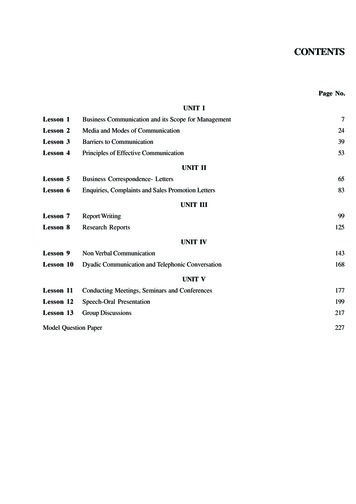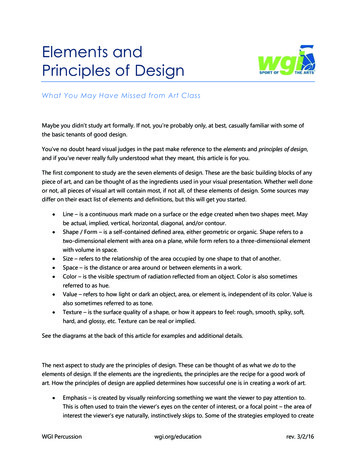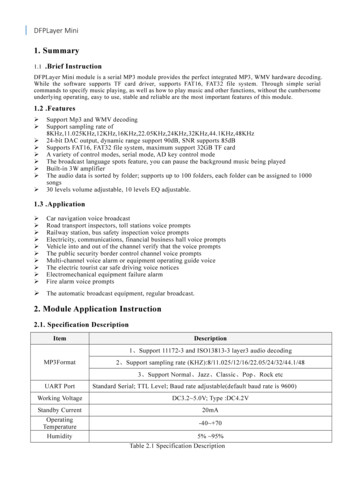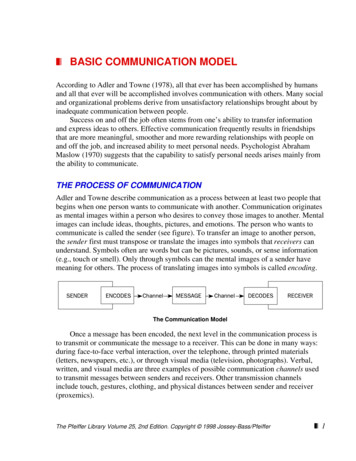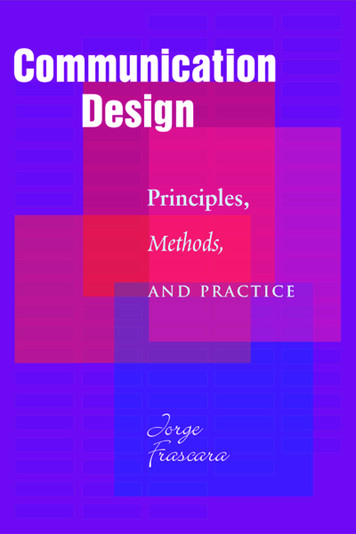
Transcription
Communications Title Pages8/3/041:11 PMPage 1CommunicationDesign
CommDesign 00 a09/03/041:47 PMPage ii
Communications Title Pages8/3/041:11 PMPage 2CommunicationDesignPrinciples,Methods,a ND PRACTICEJorgeFrascaraALLWORTH PRESSNEW YORK
CommDesign 00 a09/03/041:47 PMPage iv 2004 Jorge FrascaraAll rights reserved. Copyright under Berne Copyright Convention,Universal Copyright Convention, and Pan-American CopyrightConvention. No part of this book may be reproduced, stored in aretrieval system, or transmitted in any form, or by any means, electronic,mechanical, photocopying, recording, or otherwise, without priorpermission of the publisher.08 07 06 05 045 4 3 2 1Published by Allworth PressAn imprint of Allworth Communications, Inc.10 East 23rd Street, New York, NY 10010Cover design by Derek BacchusPage design, composition, and typography by Sharp Des!gns, Lansing, MIlibrary of congress cataloging-in-publication dataFrascara, Jorge.Communication design : principles, methods, and practice / Jorge Frascara.p. cm.ISBN: 1-58115-365-1Includes bibliographical references and index.1. Commercial art. 2. Graphic arts. 3. Visual communication. I. Title.NC997.F695 2004741.6—dc222004018346Printed in Canada
CommDesign 00 a09/03/041:47 PMPage vTo my wife, Guillermina Noël
CommDesign 00 a09/03/041:47 PMPage vi
CommDesign 00 a09/03/041:47 PMPage viiContentsxixiiiIntroduction11 A Description of the Field334Design and CommunicationThe Designer and Other Professionals“Graphic Design” versus “VisualCommunication Design”The Presence of the Designer in the MessageInformation, Redundancy, and NoiseReality and CreativityCreativity and CommunicationCommunication and AestheticsThe Main Purpose of Visual CommunicationDesign569101112viiAcknowledgments
CommDesign 00 a09/03/041:47 PMPage viiicommunication design152 Historical Context172232The Nineteenth CenturyThe Twentieth CenturyThe Design of Typefaces573 Design Principles: FunctionalRequirements58626374Perception and MeaningLanguage and SignificationCommunicationAesthetics914 Methods and Planning9395122Design MethodsThe Design ProcessThe Design Process: Two Examples1295 The Practice: Professional Areas129138152160167167Design for InformationDesign for PersuasionDesign for EducationDesign for AdministrationElements and SystemsTwo Dimensions, Three Dimensions,and Movementviii
CommDesign 00 a09/03/041:47 PMPage ixcontentsix1696 Computer Technologies andCommunication Design170172The Computer as a Production ToolDesign for Electronic Media1857 Culture and Society189Conclusion191Bibliography196Index
CommDesign 00 a09/03/041:47 PMPage x
CommDesign 00 a09/03/041:47 PMPage xiAcknowledgmentsi owe what i am to all those who,some- how or other, have had a profound effect onmy life. Sometimes through an influential sentence,sometimes through years shared, sometimes throughtheir work. Herbert Spencer taught me to do fieldresearch in a forty-five-minute conversation in 1974.In another forty-five-minute conversation ten yearslater, Paul Rand made me see the value of looking atone’s own work with a critical eye. At a conference inZurich in 1977, Richard Saul Wurman said two thingsthat stuck in my mind because of their clarity anddirectness. When it comes to being clear and direct,I keep on learning from Ronald Shakespear and fromGérard Paris-Clavel. Working with Tom Nelson hasbeen a permanent source of learning and joy. Thework of Armin Hofmann and Juan Carlos Distéfanomade me think about form, back in the 1960s. TomásMaldonado taught me the value of always beingvigilant and informed. Rubén Fontana, the power oftenacity and humility. From Juan Carrera I learned toxi
CommDesign 00 a09/03/041:47 PMPage xiicommunication designthink critically, to put things together and to takethem apart, to see the patterns that connect, asGregory Bateson would put it. Bernd Meurer mademe discover different ways of looking at everything:the principles behind the instances of design action.To Ronald Davey I owe a sensitivity to precision inlanguage and a huge debt for my coming to Canada.I owe lots of joy and learning to Steve Heller, JohnAston, Peter Kneebone, Willy DeMajo, SusumuSakane, Marijke Singer, Paul Stiff, Paul Mijksenaar,Erskine Childers, Dietmar Winkler, SharonPoggenpohl, Karel van der Waarde, David Sless, andmany others. And the list keeps on growing. Thereferences in this book show authors to whom I owemany ideas, as well as to others I do not explicitly cite,such as Anthony Wilden, Gilles Deleuze, and FelixGuatari. To my colleagues Sue Colberg and BonnieSadler Takach, my thanks for their support and theircontinuing friendship. My wife, Guillermina Noël,taught me how valuable and enjoyable all these thingscan be, and continues to keep me vigilant abouteverything I say. I thank Nicole Potter and TadCrawford at Allworth Press for the opportunity tomake this work public.xii
CommDesign 00 a09/03/041:47 PMPage xiiiIntroductionthis book is intended to outline thefield of communication design, its areas of concern,its working methods, and its purposes. It is directedat visual communication design students (not atexperienced designers) and includes discussions ofsome areas that are bound to grow and change in thisera of information explosion and technologicalinnovation.The demand for designers is greater than ever. This isparticularly true because of the fast development ofnew communication technologies and the need topay attention to human factors that are outside theexpertise of computer scientists. Beyond recognizingthis phenomenon as a context, this book centerson visual communication design as a humancommunication problem—not as a technologicalproblem—and focuses on essential aspects of theprofession and of the education of designers.xiii
CommDesign 00 a09/03/041:47 PMPage xivcommunication designThis book will point out important issues in theprofession, but does not claim to provide acomprehensive survey. More than defining boundaries,it intends to identify relevant issues and their impacton the practice.Some subjects have been developed more than others.This is sometimes because of the greater experienceof the author in certain areas; sometimes because agiven problem is more important than others; andsometimes because certain topics have, to a greatextent, been left out by most of the literature.The book is written in plain language, avoiding theneologisms and jargon that often create a mystiqueabout certain problems, and make the statementsappear more scientific or sophisticated than theyactually are. This fictitious scientism or pretentiouslanguage produces a false sense of certainty thatreduces the complexity, scope, and richness of visualcommunication design problems. Hence this book hasmore descriptions than definitions, and its vocabularyis not extensive.There are several reasons why terms from linguisticsdo not appear often in this book: The visual languagedoes not have finite dictionaries or glossaries, andtherefore the linguistic duality of signifier/signified isinapplicable. The interpreter plays a more decisive rolewhen looking at images than when reading or hearingwords, and the power of contexts adds anotherelement of uncertainty to the visual language. I preferto say “organization” rather than “syntax” (althoughxiv
CommDesign 00 a09/03/041:47 PMPage xvintroduction“syntax” might appear here and there), because“syntax” is a special kind of organization, applied toverbal sequences, in which a series of rules governsentence structure. The term “organization” is broaderand more appropriate for visual communicationsbecause it confronts the reader with the infinitepossibilities of elements and arrangements, insteadof creating the notion of limitation that the word“syntax” denotes.Elements from rhetoric could have been discussed ifthe book dealt more with a linguistics-based theoryof communication, but this is not the purpose ofthis text. It is, instead, directed at discussing visualcommunication design from the experience of apractitioner and with a social sciences–oriented pointof view.Comments and criticism are welcome.jorge frascaraDepartment of Art and DesignUniversity of AlbertaEdmonton, Alberta, T6G 2C9Canadafrascara@ualberta.caxv
CommDesign 00 a09/03/041:47 PMPage xvi
CommDesign 0109/03/041:47 PMPage 1CHAPTER 1A Descriptionof the Fieldthe term “visual communication design” issubject to a long series of interpretations. The differentdefinitions of the word “design” in everyday languagehave contributed to a lack of precision in understanding the job of the visual communication designer.Design is generally understood as the physical productderived from the activity, but the activity itself is oftenoverlooked. Expressions such as “the beautiful designsof aboriginal fabrics” incorrectly use the term “design”instead of more appropriate terms like “ornaments,”“decorations,” or “patterns.” People also speak of thebeauty of the designs that the waves leave on thebeach, or other natural forms. When a profession’sname includes a word that refers as much to a naturalobject as to an activity and an industrial product, therewill certainly be confusion in the minds of many.Whereas the public tends to perceive “design” asreferring to objects, designers tend to center the wordon action, and see the product as a final step in a longjourney. To design, for the contemporary designer, is1
CommDesign 0109/03/041:47 PMPage 2communication designan intentional activity. It is connected to neither themarks on the beach nor the repetition of a traditionalornamentation. To design is to invent, to project, toprogram, to coordinate a long list of human andtechnical factors, to translate the invisible into thevisible, and to communicate. It involves judgmentcalls, the implementation of knowledge, thegeneration of new knowledge, and the use of educatedintuition and decision-making. In this book, theword “design” will be used to refer to the processof conceiving, planning, projecting, coordinating,selecting, and organizing a series of elements—normally textual and visual—for the creation of visualcommunications. The word “design” will also be usedin relation to the objects created by that process. Thewords “visual communication” modify the word“design,” and relate it to the production of visualobjects aimed at communicating specific messages.The three words put together, “visual communicationdesign,” overflow the sum of their individualmeanings to become the name of a profession whosedescription is in part the aim of this book. To proposea working definition for now, I would say that visualcommunication design, seen as an activity, is theaction of conceiving, programming, projecting, andrealizing visual communications that are usuallyproduced through industrial means and are aimed atbroadcasting specific messages to specific sectors ofthe public. This is done with a view toward having animpact on the public’s knowledge, attitudes, orbehavior in an intended direction. A graphic designis an object created by that activity (Gorb 6).2
CommDesign 0109/03/041:47 PMPage 3a description of the fieldDesign and CommunicationThe visual communication designer works on theinterpretation, organization, and visual presentation ofmessages. Sensitivity toward form should go hand inhand with sensitivity toward content. Publicationdesigners organize not only typography but alsowords. Their work concentrates on the effectiveness,appropriateness, beauty, and economy of the messages.This job, beyond cosmetics, has to do with theplanning and structuring, production, and evaluationof communications.The Designer and Other ProfessionalsRarely does the communication designer work withtext-free images. In advertising, the writer is in mostcases a key member of the communication team. Inother areas, such as the design of books and bookcovers, a preexisting text drives the content to bevisualized.In many cases, the designer requires contributionsfrom photographers, illustrators, animators, computerprogrammers, calligraphers, and draftsmen; otherspecialists who are less connected to the designprofession are often needed as well, depending on thecontent and the audience of a given project. Thedesigner must consider equally the communicationalstrategy and its realization the way a music conductormust know the range of the instruments without3
CommDesign 0109/03/041:47 PMPage 4communication designnecessarily knowing how to play them all. Fundamentally, the designer’s job is that of a coordinator.Visual communication designers coordinate research,conception, and realization, hiring specialists andusing information related to the needs of each project.Given that the job of the designers includesinteracting with other specialists, they must have anability to work in interdisciplinary teams and toestablish good interpersonal relations. In the finalanalysis, designers are specialists in humancommunication, and their specific medium is visual.“Graphic Design” versus “VisualCommunication Design”It is necessary to recognize that the term “graphicdesigner” has contributed to the obscure profile of theprofession. Although better than “graphic artist” andfar better than “artist,” the term still places too muchemphasis on the graphic, physical element and omitsmore essential aspects of the profession—the mainaim of which is not the creation of graphic forms butthe creation of effective communications. Althoughthe most widely accepted term is indeed “graphicdesigner,” it is more descriptive and appropriate tosay “visual communication designer,” because thisdefinition includes three essential elements of theprofession: a method (design); an objective(communication); and a medium (vision).4
CommDesign 0109/03/041:47 PMPage 5a description of the fieldThe Presence of the Designerin the MessageDesigners—as opposed to artists—are not normallythe source of the messages that they communicate. Inaddition, and again as opposed to artists, the job ofcommunication designers must normally be free of thepersonal presence of the author. This is done to avoidnoise in communications that are expected to putclients in touch with their intended audience. Anotherexample from music clarifies this point: According toan article published by the New York Times, a newlyappointed conductor of the Philadelphia SymphonyOrchestra had trouble persuading the musicians thatthe orchestra was supposed to be concerned withquality, not with identity. The previous conductor hadtried to develop a distinct style during his tenure. Thecentral problem, the new conductor argued, was notto obtain a “Philadelphia sound,” but the sound ofHaydn, or Beethoven, or Stravinsky, or whomever thecomposer to be interpreted might be.While it is commonplace to recognize the creator of apainting by its style, it is not desirable to recognizedesigners through their work, particularly when theirpresence creates noise in the interpretation of amessage. Posters designed by famous artists—likemany produced for the Lincoln Center film festivals—can lend prestige to an institution, but recognizablestyles tend to call more attention to the authors thanto what the posters announce. In this situation, noiseis created in the communicational process—howeverbeautiful the poster could be. The content the posters5
CommDesign 0109/03/041:47 PMPage 6communication designmean to communicate is reduced to a secondary role.This is not a rare occurrence. When famous artists areinvited to design posters for cultural events, they tendto produce images that basically represent their ownwork. This has happened many times with postersdesigned by painters such as by Frank Stella, JosefAlbers, Andy Warhol, and Roy Lichtenstein. JosefMüller-Brockmann’s film poster, by contrast, showsan appropriate solution to a similar problem, since itvisualizes the notions of movement and filmstripthrough an intelligent typographic play of transparency. The tonal atmosphere is also an appropriatereference to the movie theater experience (Figure 1).A poster by Albers that announces a show by Alberswould be quite fitting. What in one context may benoise, in another may be information.Information, Redundancy, and NoiseThe three concepts—information, redundancy, andnoise—come from information science and help toclarify some communication design problems.The concept of “information” is connected to novelty,which relates to the level of novelty present in amessage. The level of information in a message is ininverse relation to its probability. “The main axiom of[information] theory is that the information carried byone signal in a string of signals—say a word in asentence—is an inverse function of the probability of6
CommDesign 0109/03/041:47 PMPage 7a description of the field1. Josef Müller-Brockmann(1960), Der Film, poster.(Reproduced by permission, Shizuko MüllerYoshikawa)that signal occurring in that context. Thus if I say‘good morning’ at breakfast I may mumble the firstword without much being lost on you: in that contextthe word has high probability and therefore lowinformation value” (Petit 22). Therefore, for example,a detergent’s package that reads “New formula” mightprovide information, but this becomes redundant if alldetergents on the market include the same claim, andit gets lost in the context.7
CommDesign 0109/03/041:47 PMPage 8communication designThe connoted information in the example is that “newformula” implies that the product is (a) better than theprevious one, and (b) better than competing brands.When competing brands also state that they have anew, and better, formula, the messages cancel eachother out and become “This detergent is similar to allother detergents” and, possibly, “This ‘new formula’claim is not even true, and if it is, it is not necessarilybetter.” This shows the complexity of communicationprocesses and the presence of information in relationto expectations and redundancy.On the positive side, “redundancy” has at least twofunctions: insistence and clarification. Insistence, inthe form of repetition, is a rhetorical strategy that,when properly used, can lead to a better memorizationof the information, while giving prominence to amessage. Many people end up believing whateveris sufficiently repeated. The use of repetition asclarification often happens when the same informationis presented in different ways—sometimes usingdifferent coding systems—to ensure that theinformation will be understood by a good number ofdifferent people. In some cases, this strategy mightgenerate noise, when certain target groups becomedistracted by the presence of codes they do notunderstand.“Noise” is any distraction that appears between theinformation and the public, thereby interfering with,distorting, obliterating, or hiding the message. In thecase of communication design, noise can appear at apurely visual level, because of elements or techniques8
CommDesign 0109/03/041:47 PMPage 9a description of the fieldthat obscure the visibility of the stimuli presenting theinformation. It can also be caused at a semantic level,when the logic of the message does not match thecognitive culture of its intended audience.Noise can exist in the channel (medium), the code(language), or the form (aesthetics or style). Noiseis created by irrelevant information, obliteratingelements, or poor technical quality. The consequenceof noise can range from a lack of clarity to the totalincomprehensibility of a message.Reality and Creativity“Within this view, designers would appear as guides,as advisors, that, supported by extensive practice andexperience, would provide users and decision-makerswith the originality of their analysis, their creativity,and their realism.” With these words, J. Mullender,former director of the Centre of Industrial Creation ofFrance identified important aspects of the designer’srole back in 1979: originality of analysis, creativity, andrealism. Indeed, a good balance between creativity andrealism is missing in many artists’ posters for theLincoln Center film festivals.Creativity in design must exist within establishedlimitations. Total freedom should not be taken as anessential condition to permit creativity, and creativityshould not be seen as pertaining exclusively to thearts. Creativity can be defined as the ability to9
CommDesign 0109/03/041:47 PMPage 10communication designconceive unexpected solutions to apparentlyunsolvable problems. Without magic or mysterioustouches, creativity is nothing other than intelligence—an intelligence that, in certain ways, can be developedand that, in the midst of a flood of unconnected andchaotic data, allows one to discover connections thatothers do not discover, see differences that others donot see, and, as a consequence, produce new andsurprising integrations (Hofstadter 26).The alleged opposition between creativity and realismhas no grounds except to those people whose romanticconceptions link creativity with Van Gogh’s madnessor Utrillo’s excessive drinking. Creativity—althoughrequiring uncommon skills—is based on a number ofcontrollable processes, such as observation, attention,research, and analysis, and, to a certain extent, on thepossession of thinking strategies that combineflexibility with efficiency.Creativity and CommunicationThe duality of “creativity and communication” cannotbe stated as an opposition. Clarity is not opposed tocreativity in communication design. Creativity canmake complex messages easy to understand, and thelack of it can render simple messages obscure.The belief that clarity is opposed to creativity is basedon misconceptions about both creativity and design:10
CommDesign 0109/03/041:47 PMPage 11a description of the fieldCreativity in design has nothing to do with selfexpression and an indulgent egocentrism. It requires,instead, an objective and flexible intelligence, anability to analyze any problem from a multiplicity ofviewpoints, so as to be able to understand theintentions of a client (the originator of the message),and the possible perceptions that a wide range ofsectors of the public could have of a given message.The creativity of the designer is similar to that of theactor who, working in different genres, addressesvarious audiences and makes diverse literary creationscome alive on stage.Communication and AestheticsCommunication and aesthetics are not in opposition,either. The visual communication design problemcannot be seen as a need to choose betweencommunication and aesthetics, because aesthetics isa communication requirement to be satisfied incommunication design. Beauty and visual sophistication are important dimensions of the work of thedesigner, but they must be integrated within theproject’s content and its public, and cannot be dealtwith on the basis of allegedly universal and contextindependent criteria. This topic will be discussed laterin the section on aesthetics.11
CommDesign 0109/03/041:47 PMPage 12communication designThe Main Purpose of VisualCommunication DesignEvery piece of communication design arises from theneed to communicate a specific message, and toobtain a desired response; in other words, it comesto exist because someone wants to say somethingto someone else, so that this someone else doessomething in particular. This is why one cannotjudge the quality of a design only on the basis ofits visual appearance. The aesthetic aspects that affectthe selection of some designs in juried exhibitions andin history books should not distort the evaluation ofthe main purpose of visual communication design,which centers on generating a certain response from acertain public. It seems, however, that some designersconceive their pieces with design exhibitions andbooks in mind, to the detriment of the clarity,effectiveness, and appropriateness of the materialproduced. Although some designs can becomeornaments, historical documents, or aestheticparadigms—once they’ve accomplished their primarygoal—visual communication design is not just aboutlooks; it is fundamentally about performance.Sometimes, the concern for originality and beautyhas contributed to the development of visualsophistication and cultural value, but it has notpromoted the communicational function of design,and has often distracted designers from thefundamental purpose of their work. Many examplesof this can be found in the avant-garde work ofthe 1920s.12
CommDesign 0109/03/041:47 PMPage 13a description of the fieldTo understand visual communication design properly,we have to think more about actions than aboutobjects. The emphasis should not be on the product,given that this is only a means. Essentially, thedesigner generates the communication by designingan event, an act in which the public interacts withthe design. The objective of the designer is, therefore,the design of communicational situations. Further, theimportant issue is not the communicational act itself,but the impact that this has on the knowledge, theattitudes, and the behavior of people. This makes clearthe need to study the interaction between messagesand people, not only the interaction of visual elementswith one another, which has absorbed the attention ofdesigners so much in the past. Visual composition isimportant, but it is only a tool, a way of organizingthe communicational event. This communicationalevent happens over time—not only in space—and isloaded with complex human elements related tolanguage, experience, age, knowledge, education,memory, cognitive style, preferences, expectations,desires, and other perceptual, intellectual, social,cultural, and emotional dimensions. In sum, thepurpose of communication design is to affect theknowledge, attitudes, and behavior of people—something that happens after the communicationtakes place.13
CommDesign 0109/03/041:47 PMPage 14
CommDesign 02 c09/03/041:48 PMPage 15CHAPTER 2Historical Contexta brief historical survey will help ussee the development of the definition of visualcommunication design as both an activity and a publicperception issue. The perception of the visualcommunication designer as being distinct from theartist developed after the beginning of the twentiethcentury, and it has continued to change ever since.The conception presented in this book centers on anunderstanding that has evolved in the last fifty years,when the notion of visual communication design as artgave way to a growing interest in communicationalissues, ranging from cognitive psychology to marketing.It could be argued that graphic communications withspecific objectives have been developing for 25,000years. Working methods, allied fields, and educationalrequirements to practice the profession are such,however, that one cannot identify the communicationdesigner of today with the caveman warlock fromAltamira, the sixteenth-century woodcutter, or the1890s lithographer (Figures 2, 3, and 4).15
CommDesign 02 c09/03/041:48 PMPage 16communication design2. Cave painting, Altamira, Santander, Spain.Photo: Jorge Frascara.4. Henri de Toulouse-Lautrec (1891), MoulinRouge, color lithograph.3. Albrecht Dürer (1510), Mocking Christ,woodcut, from a series of five engravingsto complete the Great Passion.16
CommDesign 02 c09/03/041:48 PMPage 17historical contextWhereas prehistoric people completed their workwithin small and integrated human groups in whichgraphic communication was part of a socialcontinuum, the designer of today communicatesmessages through mass media, has no control over thefinal communicational act, and addresses a variety ofgroups whose backgrounds, views, and intentions areonly partly known.The sixteenth-century woodcutter is closer to thelithographer of the 1890s than the lithographer is totoday’s designer. In the former cases, the author wasdefined more as a craftsman, and formal/stylisticchoices were highly embedded in current styles,without conscious consideration of target audiences,subject matter, or implementation context.Today, the communicational requirements of a projectcan be met by adopting a given visual style that canbe selected from a wide variety. This requires fromthe designer a conscious control over selection criteriathat are based not on personal preferences but on ananalysis of the contexts where the communication willoperate.The Nineteenth CenturyDuring the nineteenth century, and up until thebeginning of World War I, the conception of visualcommunications was entrusted to one of twoprofessional groups: artists or printers. Often these17
CommDesign 02 c09/03/041:48 PMPage 18communication design5. (left) A. Eurich (1866),K. K. Prater, poster.6. (right) Anonymous(1861), New Goods! NewGoods!, poster.professionals came from different departments inthe same schools of arts and crafts. The printerfrequently saw art in the use of ornaments and in thecombination of different typefaces, styles, and sizes(Figures 5 and 6).The artists saw typography as a secondary element andpaid more attention to ornaments and illustrations,although in many cases lettering and image were quitewell integrated (Figures 7–11). Graphic art in thisperiod is characterized by revivals (neoclassical,neogothic), and by the eclecticism of the turn of the18
CommDesign 02 c09/03/041:48 PMPage 19historical contextcentury. The extreme typographic variations thatcharacterize much of the work of the nineteenthcentury, however, have not disappeared, as one cansee in many of today’s publications.Interest in ornamentation and in typographicvariations as marks of good design was a commonfeature in the second half of the nineteenth century.Art nouveau, with its defined stylistic choices, grew inimportance until about 1920. It maintained a highdegree of complexity—typical of the nineteenthcentury—while preserving a strong visual coherence,continued on page 21197. L. Elsinger (1896),Bauernball, poster.
CommDesign 02 c09/03/041:48 PMPage 20communication design8. An
A graphic design is an object created by that activity (Gorb 6). communication design 2 CommDesign 01 09/03/04 1:47 PM Page 2. Design and Communication The visual communication designer works on the interpretation, organization, and visual presentati

